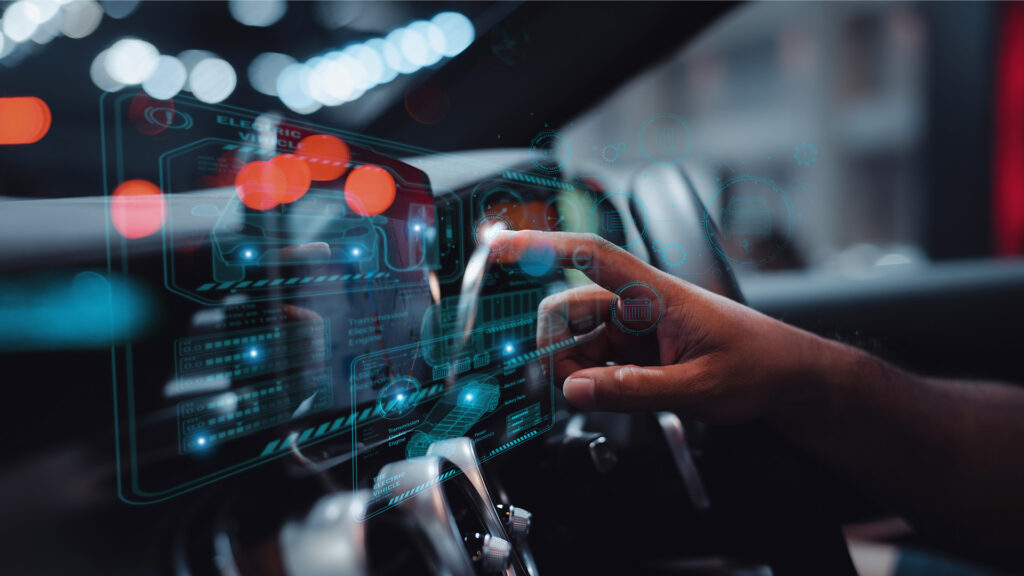
As the automotive industry moves closer and closer to fully autonomous, even lower end vehicles are evolving into rolling computers—with ever-increasing interconnectivity and complexity in the vehicle cockpit. Car buyers now expect to be connected to the outside world—and OEMs are responding to their requirements. It is estimated that by 2030, 95% of all new vehicles will incorporate intermediate or advanced infotainment, telematics and V2X capabilities to communicate between vehicles, users and infrastructure.
With these dramatic shifts in technologies from more mechanical and analog controls to those that are partially or fully digital, automotive OEMs are challenged with anticipating how customers interact with their vehicles, namely through the human-machine interface (HMI).
The HMI acts as a hub of the wheel for the vehicle cockpit’s connected user experience, integrating the spokes that provide information to the driver while sending commands to the various systems both inside and outside the car. The considerable shift toward electrification and autonomous vehicles has resulted in new regulatory requirements. These requirements have compelled OEMs and suppliers to invest more R&D into user interface hardware and software lifecycles and integration, whether their digital cockpits include a multitude of dedicated displays in a single vehicle to just a single in-dash touchscreen.
But the simplicity of a well-architected UI masks great complexity. Cockpit software design includes many considerations, such as how to integrate multiple compute domains and vehicle applications across varying operating systems. Customers have grown accustomed to smartphones being at their side—so how can OEMs keep them connected to their communication and entertainment while adhering to regulations for driver safety and attention? How can OEMs maintain brand continuity between native HMI screens, multiple connectivity solutions and those of the passengers’ personal devices? This is a complex challenge encompassing a vast number of varying requirements, especially given the increase in autonomy. OEMs can embrace these challenges by leveraging a production-proven platform to bring this all together efficiently.
Meeting OEM Challenges with Proven Innovation
Altia delivers a single, comprehensive platform to meet OEM’s cockpit software challenges and the needs and expectations of their customers. They provide a complete end-to-end cockpit software solution for OEMs by combining the best design tools, advanced technology, customization capabilities and expertise within one unified platform.
Altia has helped some of the largest OEMs create custom HMIs in various vehicles as well as develop and deploy their entire software stack—from sedans, SUVs, semis and motorcycles to electric construction-agriculture equipment and everything in between. The integration of Altia’s powerful features and hardware flexibility in over 100 million production vehicles on the road have been shaping the industry. Altia’s software solution is at the heart of over 375 vehicle dashboards for the upcoming generation.
A Comprehensive Collection of Tools and Expert Service
Altia’s cockpit software platform sets the standard for designing, developing and deploying innovative, first-class automotive user experience. The platform enables display design and deployment on any screen within a car, including instrument clusters, HUDs, infotainment displays, passenger displays and rear passenger entertainment systems. No matter how grand and challenging your vision is, Altia can enable a seamless look and feel in your vehicle cockpits to provide an immersive experience that is representative of the brands across your fleet of vehicles. By reusing the core of your work, Altia enables you to keep design cost-efficient while enabling endless opportunities to differentiate. Providing the tools and expert support you need to bring your UI from concept to production quickly and efficiently, Altia’s HMI development platform saves time and reduces production costs.
Altia Advantages for Automotive
- Hypervisor operations — HMI cockpit operates on both sides of your hypervisor
- Code generation — Quick conversion of HMI prototypes and graphics to deployable graphics code across a wide range of hardware
- Integration and display management — Guidance on how to manage and integrate cockpit real estate to create cohesive and intuitive signature UIs for customers while maintaining brand identity
- Head-up display expertise — Best-in-class HUDs integration to show system information and advanced driver-assist system (ADAS) warnings to keep drivers’ eyes on the road
- Automated testing solutions — Reduction in time-to-market HMI testing costs, minimizes human error
Integrations
Altia’s cockpit HMI platform can seamlessly integrate the following services and applications into your displays:
- Android Auto and Apple CarPlay
- Third-party mapping programs
- ADAS
- Media players
- Telematics units
- Automotive infrastructure integrations via Vehicle-to-Everything (V2X)
Altia Software Tools and Services Support Every Step of Your HMI Process
With the increasing complexity in the automotive world and increasing demand for OEMs to pull user experience and data ownership in-house, it’s easy to get overwhelmed with an approach to managing it all. Altia is here to bring all the pieces together and help OEMs to realize their automotive user experience goals. Altia guides OEMs through designing, developing and deploying their custom automotive cockpits.
Altia’s complete automotive software platform supports every step of the development process, from concept design through delivery. Altia automotive solutions enable OEMs to meet their digital cockpit goals today and in the future. Altia understands these system complexities and has the proven tools to help you with your automotive software challenges.
Ready to start your automotive cockpit development journey? Altia delivers the expertise, software and services to guide you throughout the process to meet your needs and realize your goals. We would love to hear about your project and how we can help you get it on the road.
Visit www.altia.com/get-started.